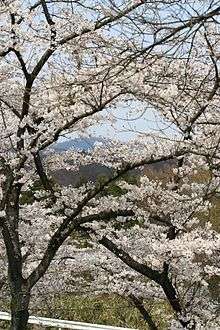Mount Ikoma
Mount Ikoma (生駒山, Ikoma-yama) is a mountain on the border of Nara Prefecture and Osaka Prefecture in Japan. It is the highest peak in the Ikoma Mountains with a height of 642 meters.
| Mount Ikoma | |
|---|---|
| 生駒山 | |
 A view of Mt. Ikoma | |
| Highest point | |
| Elevation | 642 m (2,106 ft) |
| Coordinates | 34°40′42.43″N 135°40′44.29″E |
| Naming | |
| Pronunciation | Japanese: [ikomajama] |
| Geography | |
| Parent range | Ikoma Mountains |
Mount Ikoma is a part of Kongō-Ikoma-Kisen Quasi-National Park. It is one of the most famous picnic spots in the Kansai region. On the top of the mountain, there are many TV towers for broadcasting to the Kansai region and Ikoma Sanjo Amusement Park.

History
Mount Ikoma was an important object of worship for ancient Japanese people. On the east foot of the mountain, Ikoma Jinja (literally 'Shrine for Mount Ikoma') has been extant since the 5th century. The mountain and the Hozan-ji temple near the summit were traditionally celebrated as national scenery and included in well-known woodblock series such as the "Sixty-eight National Views."
After the Second World War, the west foot of the mountain started to host religious institutions serving the spiritual needs of Korean immigrants and residents of Korean descent, mostly women.[1]
The city itself was transformed by the Kintetsu train tunnel. Pilgrims and visitors to the temple grew, as well as tourist-related inns and eating establishments. After the Pacific War, the area below the temple developed into an active red-light and entertainment district. The local geisha prospered.
Ikoma today retains a bit of the old atmosphere with its winding, narrow streets. Ikoma nurtured lively traditional Japanese arts such as dance and varieties of Japanese music. The walk down from the mountain temple to the town is a noted area for cherry blossoms, as is the mountain itself with its Ikoma Skyline Drive developed by Kintetsu Corporation.
Access
- Ikoma Sanjo Station of Ikoma Cable Line
References
- Mai Takano, Korean residents find peace of mind at Mount Ikoma temples, Japan Times Nov. 16, 2012.
External links

- Ministry of the Environment of Japan
- Official website of the Geographical Survey Institute in Japan

.jpg)